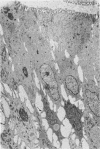Abstract
An animal model for Clostridium butyricum necrotizing cecitis has been developed in axenic chickens inoculated orally between 2 and 50 days of life. Cecitis was obtained with two C. butyricum strains isolated from neonatal necrotizing enterocolitis and not with a Clostridium beijerinckii strain from dairy products; the rate of colonization of the intestinal tract by this strain was lower than that obtained with C. butyricum strains. The clinical findings showed a slow gain in body weight. The cecitis lesions were well developed 3 and 4 weeks after oral inoculation, including enlargement with an increase of the cecum weight-body weight ratio, a marked hyperplasia, congestion, inflammatory infiltrate and pneumatosis of the cecal wall and mesentery, hemorrhage in the lamina propria and submucosa, and ulcerations and necrotic areas in the mucosa. By immunofluorescence and electron microscopy, the bacterial cells were located in the cecal lumen and in necrotic areas of the mucosa. The presence of 4% lactose in the diet seemed to be a prerequisite for the development of cecitis in chickens. A gradual rise of fluorescent antibodies in the sera was observed.
Full text
PDF
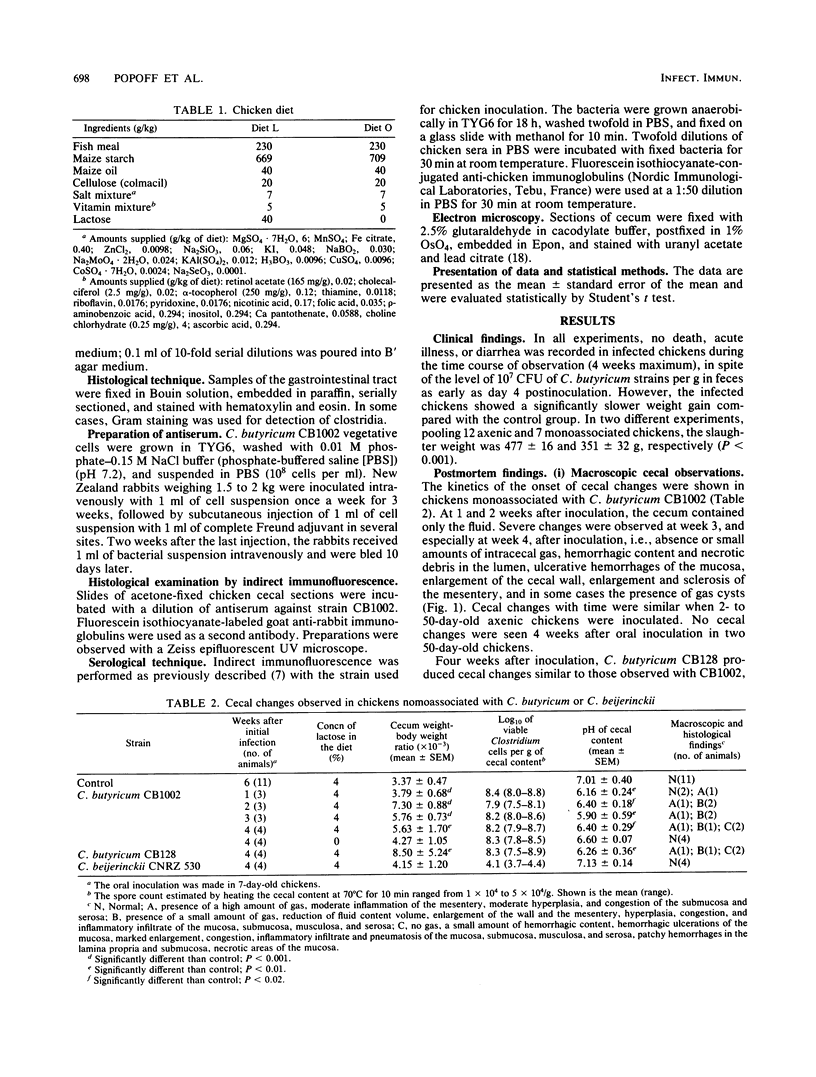
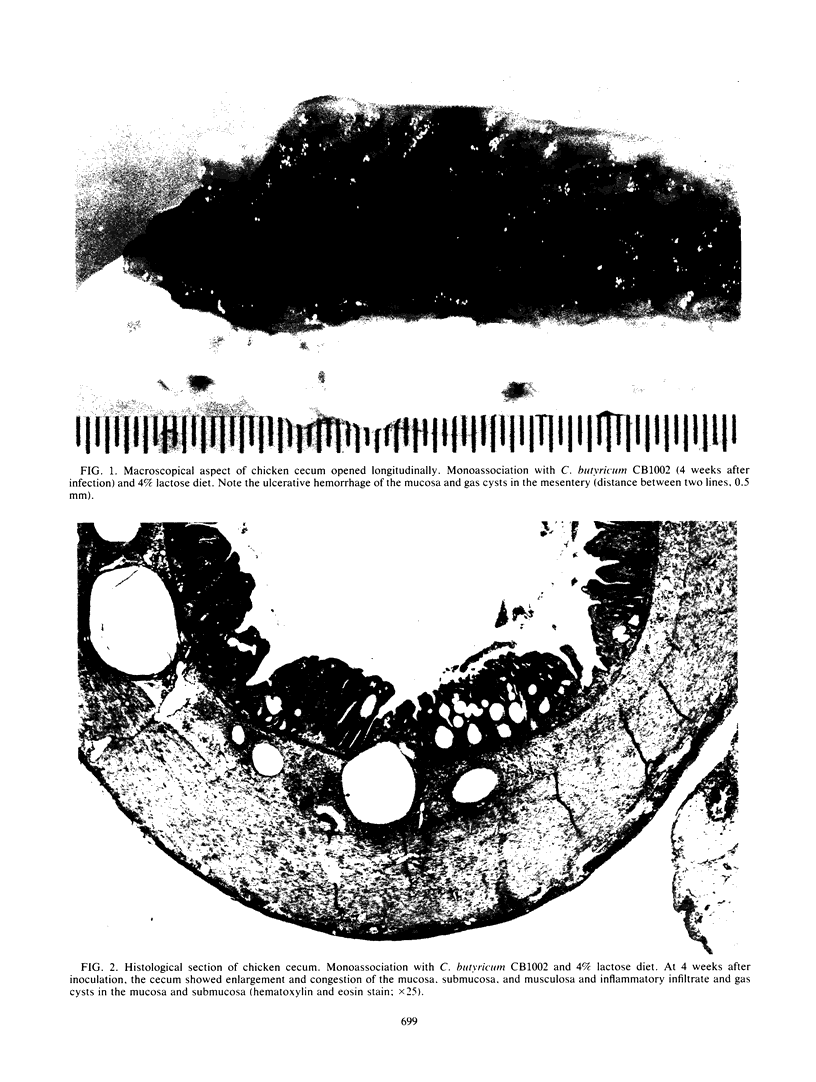
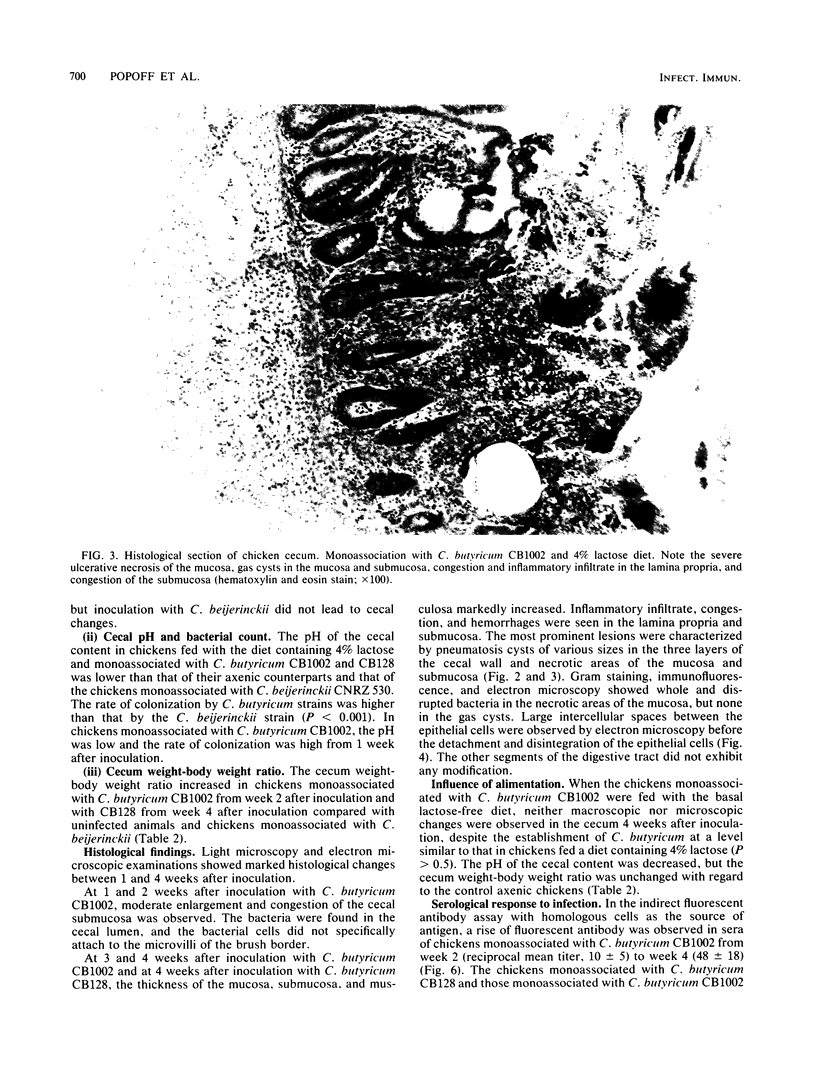
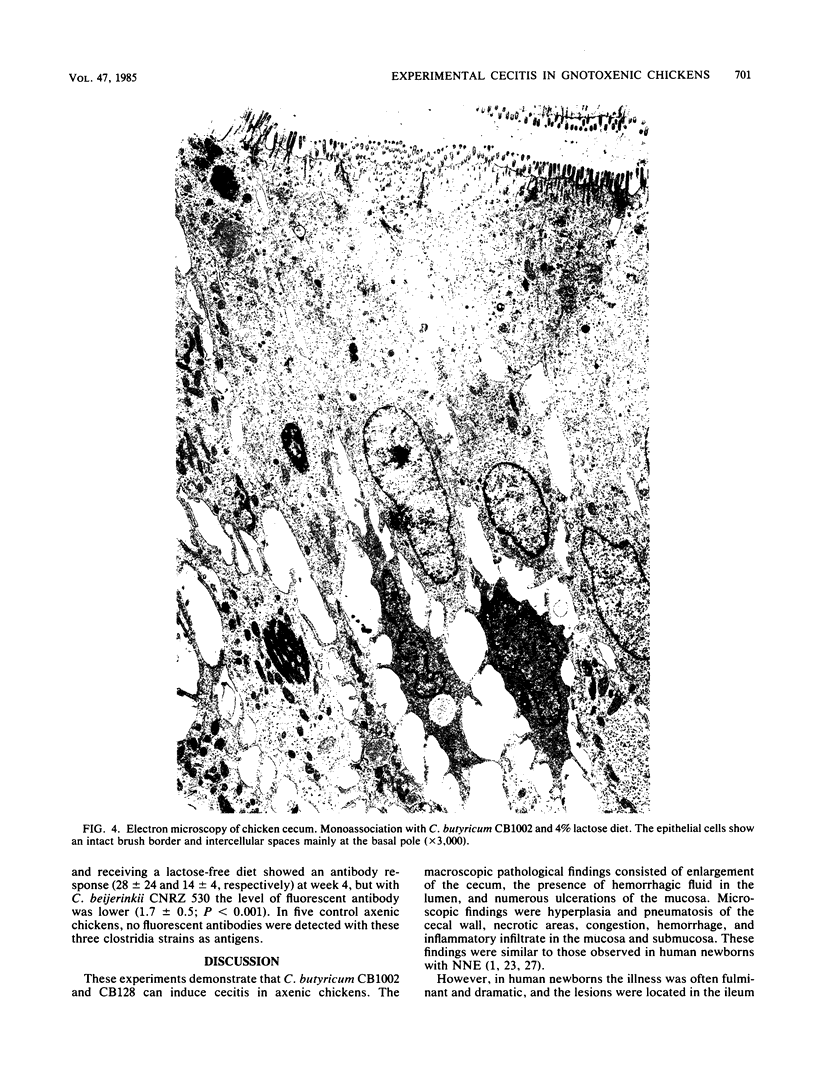

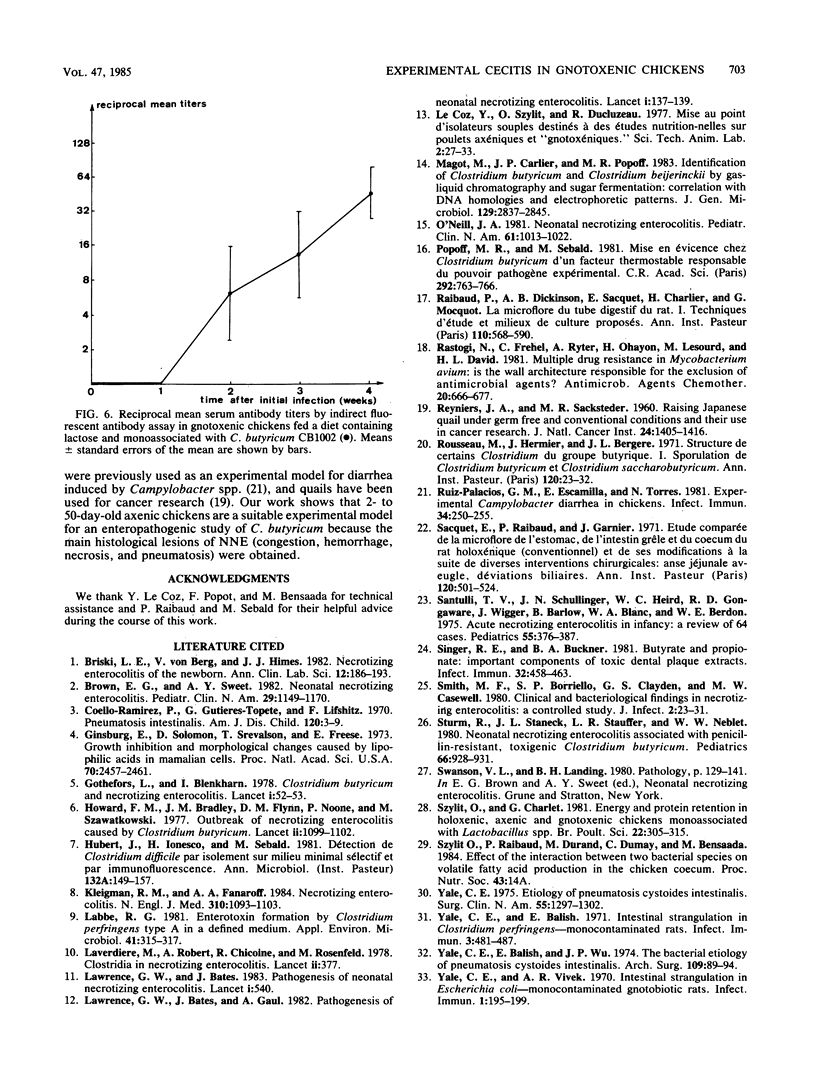
Images in this article
Selected References
These references are in PubMed. This may not be the complete list of references from this article.
- Briski L. E., Von Berg V., Humes J. J. Necrotizing enterocolitis of the newborn. Ann Clin Lab Sci. 1982 May-Jun;12(3):186–193. [PubMed] [Google Scholar]
- Brown E. G., Sweet A. Y. Neonatal necrotizing enterocolitis. Pediatr Clin North Am. 1982 Oct;29(5):1149–1170. doi: 10.1016/s0031-3955(16)34252-3. [DOI] [PubMed] [Google Scholar]
- Coello-Ramírez P., Gutierres-Topete G., Lifshitz F. Pneumatosis intestinalis. Am J Dis Child. 1970 Jul;120(1):3–9. doi: 10.1001/archpedi.1970.02100060037002. [DOI] [PubMed] [Google Scholar]
- Ginsburg E., Salomon D., Sreevalsan T., Freese E. Growth inhibition and morphological changes caused by lipophilic acids in mammalian cells. Proc Natl Acad Sci U S A. 1973 Aug;70(8):2457–2461. doi: 10.1073/pnas.70.8.2457. [DOI] [PMC free article] [PubMed] [Google Scholar]
- Gothefors L., Blenkharn I. Clostridium butyricum and necrotising enterocolitis. Lancet. 1978 Jan 7;1(8054):52–53. doi: 10.1016/s0140-6736(78)90406-3. [DOI] [PubMed] [Google Scholar]
- Howard F. M., Flynn D. M., Bradley J. M., Noone P., Szawatkowski M. Outbreak of necrotising enterocolitis caused by Clostridium butyricum. Lancet. 1977 Nov 26;2(8048):1099–1102. doi: 10.1016/s0140-6736(77)90546-3. [DOI] [PubMed] [Google Scholar]
- Hubert J., Ionesco H., Sebald M. Détection de Clostridium difficule par isolement sur milieu minimal sélectif et par immunofluorescence. Ann Microbiol (Paris) 1981 Mar-Apr;132(2):149–157. [PubMed] [Google Scholar]
- Kliegman R. M., Fanaroff A. A. Necrotizing enterocolitis. N Engl J Med. 1984 Apr 26;310(17):1093–1103. doi: 10.1056/NEJM198404263101707. [DOI] [PubMed] [Google Scholar]
- Labbe R. G. Enterotoxin formation by Clostridium perfringens type A in a defined medium. Appl Environ Microbiol. 1981 Jan;41(1):315–317. doi: 10.1128/aem.41.1.315-317.1981. [DOI] [PMC free article] [PubMed] [Google Scholar]
- Laverdière M., Robert A., Chicoine R., Salet D., Rosenfeld R. Clostridia in necrotising enterocolitis. Lancet. 1978 Aug 12;2(8085):377–377. doi: 10.1016/s0140-6736(78)92979-3. [DOI] [PubMed] [Google Scholar]
- Lawrence G., Bates J., Gaul A. Pathogenesis of neonatal necrotising enterocolitis. Lancet. 1982 Jan 16;1(8264):137–139. doi: 10.1016/s0140-6736(82)90383-x. [DOI] [PubMed] [Google Scholar]
- Magot M., Carlier J. P., Popoff M. R. Identification of Clostridium butyricum and Clostridium beijerinckii by gas-liquid chromatography and sugar fermentation: correlation with DNA homologies and electrophoretic patterns. J Gen Microbiol. 1983 Sep;129(9):2837–2845. doi: 10.1099/00221287-129-9-2837. [DOI] [PubMed] [Google Scholar]
- O'Neill J. A., Jr Neonatal necrotizing enterocolitis. Surg Clin North Am. 1981 Oct;61(5):1013–1022. [PubMed] [Google Scholar]
- Popoff M. R., Sebald M. Mise en évidence chez Clostridium butyricum d'un facteur thermostable responsable du pouvoir pathogène experimental. C R Seances Acad Sci III. 1981 Mar 23;292(12):763–766. [PubMed] [Google Scholar]
- Raibaud P., Dickinson A. B., Sacquet E., Charlier H., Mocquot G. La microflore du tube digestif du rat. I. Techniques d'étude et milieux de culture proposés. Ann Inst Pasteur (Paris) 1966 Apr;110(4):568–590. [PubMed] [Google Scholar]
- Rastogi N., Frehel C., Ryter A., Ohayon H., Lesourd M., David H. L. Multiple drug resistance in Mycobacterium avium: is the wall architecture responsible for exclusion of antimicrobial agents? Antimicrob Agents Chemother. 1981 Nov;20(5):666–677. doi: 10.1128/aac.20.5.666. [DOI] [PMC free article] [PubMed] [Google Scholar]
- Rousseau M., Hermier J., Bergere J. L. Structure de certains Clostridium du groupe butyrique. I. Sporulation de Clostridium butyricum et Clostridium saccharobutyricum. Ann Inst Pasteur (Paris) 1971 Jan;120(1):23–32. [PubMed] [Google Scholar]
- Ruiz-Palacios G. M., Escamilla E., Torres N. Experimental Campylobacter diarrhea in chickens. Infect Immun. 1981 Oct;34(1):250–255. doi: 10.1128/iai.34.1.250-255.1981. [DOI] [PMC free article] [PubMed] [Google Scholar]
- Sacquet E., Raibaud P., Garnier J. Etude comparée de la microflore de l'estomac, de l'intestin grêle et du caecum du rat "holoxénique" (conventionnel), et de ses modifications à la suite de diverses interventions chirurgicales: anse aveugle jéjunale, déviations biliaires. Ann Inst Pasteur (Paris) 1971 Apr;120(4):501–524. [PubMed] [Google Scholar]
- Singer R. E., Buckner B. A. Butyrate and propionate: important components of toxic dental plaque extracts. Infect Immun. 1981 May;32(2):458–463. doi: 10.1128/iai.32.2.458-463.1981. [DOI] [PMC free article] [PubMed] [Google Scholar]
- Smith M. F., Borriello S. P., Clayden G. S., Casewell M. W. Clinical and bacteriological findings in necrotising enterocolitis: a controlled study. J Infect. 1980 Mar;2(1):23–31. doi: 10.1016/s0163-4453(80)91727-2. [DOI] [PubMed] [Google Scholar]
- Sturm R., Staneck J. L., Stauffer L. R., Neblett W. W., 3rd Neonatal necrotizing enterocolitis associated with penicillin-resistant, toxigenic Clostridium butyricum. Pediatrics. 1980 Dec;66(6):928–931. [PubMed] [Google Scholar]
- Szylit O., Charlet G. Energy and protein retention in holoxenic, axenic and gnotoxenic chickens monoassociated with Lactobacillus spp. Br Poult Sci. 1981 Jul;22(4):305–315. doi: 10.1080/00071688108447890. [DOI] [PubMed] [Google Scholar]
- Sántulli T. V., Schullinger J. N., Heird W. C., Gongaware R. D., Wigger J., Barlow B., Blanc W. A., Berdon W. E. Acute necrotizing enterocolitis in infancy: a review of 64 cases. Pediatrics. 1975 Mar;55(3):376–387. [PubMed] [Google Scholar]
- Yale C. E., Balish E. Intestinal Strangulation in Clostridium perfringens-Monocontaminated Rats. Infect Immun. 1971 Mar;3(3):481–487. doi: 10.1128/iai.3.3.481-487.1971. [DOI] [PMC free article] [PubMed] [Google Scholar]
- Yale C. E., Balish E., Wu J. P. The bacterial etiology of pneumatosis cystoides intestinalis. Arch Surg. 1974 Jul;109(1):89–94. doi: 10.1001/archsurg.1974.01360010067017. [DOI] [PubMed] [Google Scholar]
- Yale C. E. Etiology of pneumatosis cystoides intestinalis. Surg Clin North Am. 1975 Dec;55(6):1297–1302. doi: 10.1016/s0039-6109(16)40784-x. [DOI] [PubMed] [Google Scholar]
- Yale C. E., Vivek A. R. Intestinal Strangulation in Escherichia coli-Monocontaminated Gnotobiotic Rats. Infect Immun. 1970 Feb;1(2):195–199. doi: 10.1128/iai.1.2.195-199.1970. [DOI] [PMC free article] [PubMed] [Google Scholar]






